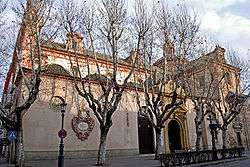Santa María Magdalena, Seville

Santa María Magdalena is a Baroque church in Seville, southern Spain.
It was built in 1691-1709 under design of architect Leonardo de Figueroa, above a medieval church built after the Christian conquest of the city in 1248.
The façade has three portals, one featuring a sculpture of "St. Dominic" by Pedro Roldán. Above the portals are an oculus, sided by two blue spheres symbolizing the mystery of the rosary, and a bell-gable (1697). All the exterior of the church is characterized by a large use of blue and red decorative motifs.
The interior has a nave and two aisles, a transept, five chapels (including the only one remaining from the previous edifice, that of the Brotherhood of the Fifth Angusty) and a presbytery. The central nave is surmounted by an octagonal dome, whose exterior is decorated with fugres resembling Inca Indians. The interior of the church has a rich Baroque decoration sith stuccoes and gold patina.
The Chapel of the Dulce Nombre de Jesús has another work by Roldán and a Christ Reborn by Jerónimo Hernández. The high altar is in Baroque style (18th century), with sculptures by Pedro Duque y Cornejo and Francisco de Ocampo, while the retable of the Assumption was executed by Juan de Mesa. Other artworks include frescoes by Lucas Valdés and two canvasses by Francisco de Zurbarán
| Wikimedia Commons has media related to Iglesia de Santa María Magdalena (Sevilla). |
Coordinates: 37°23′25″N 5°59′55″W / 37.39028°N 5.99861°W
External links
- Page at TripAdvisor website (English)